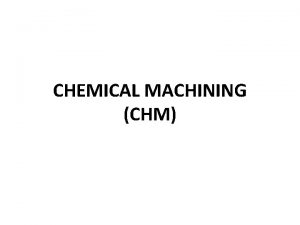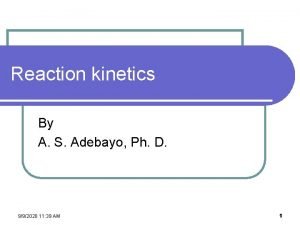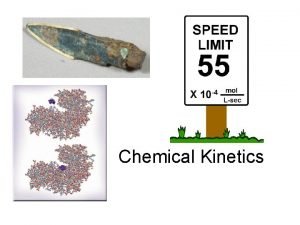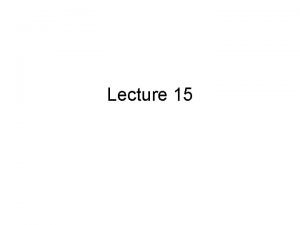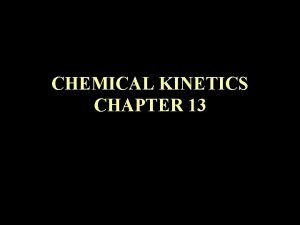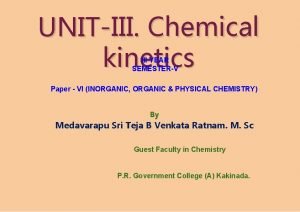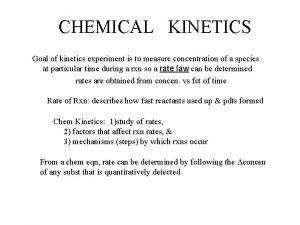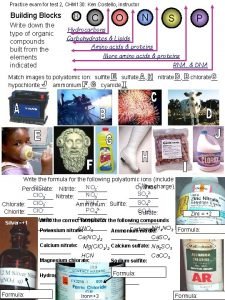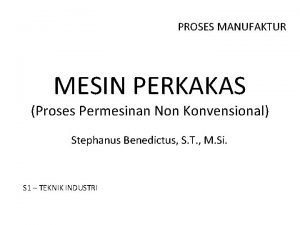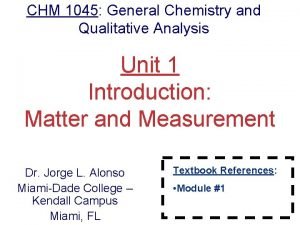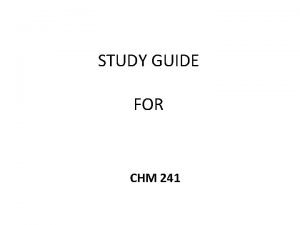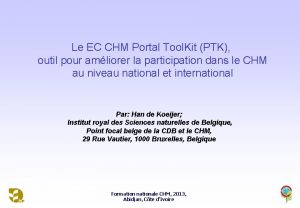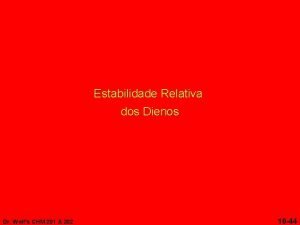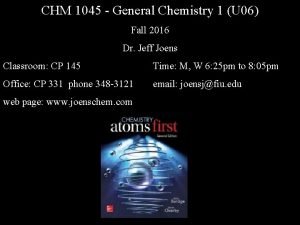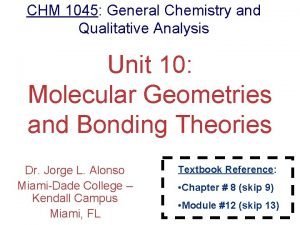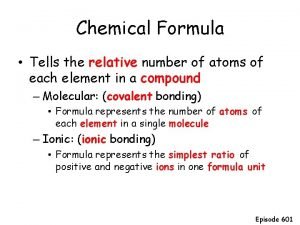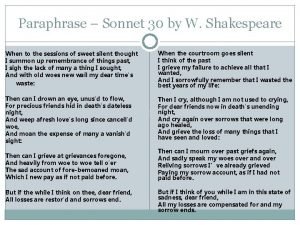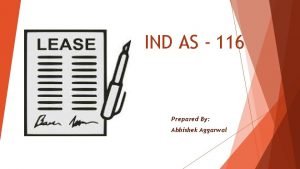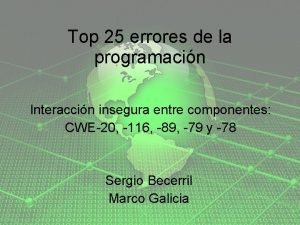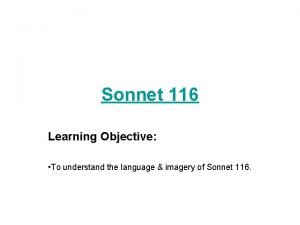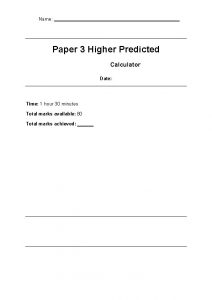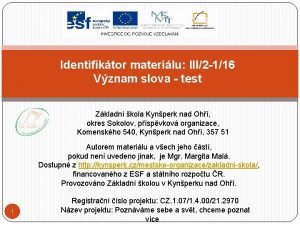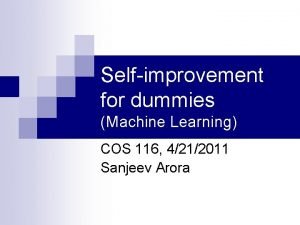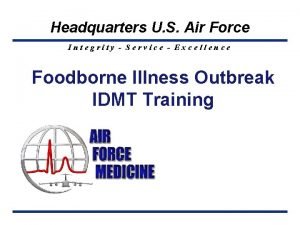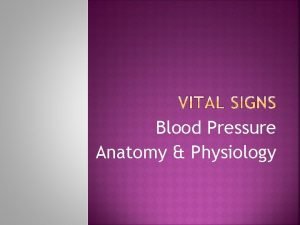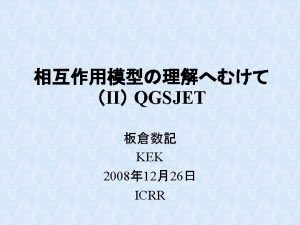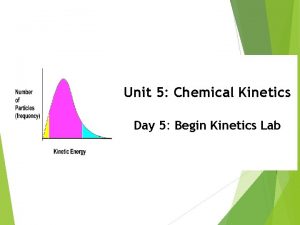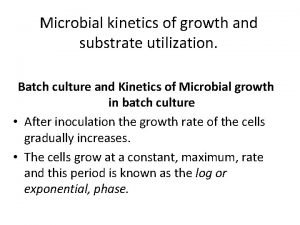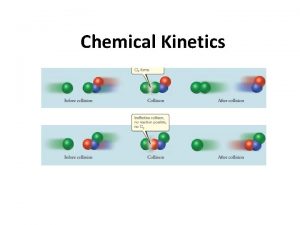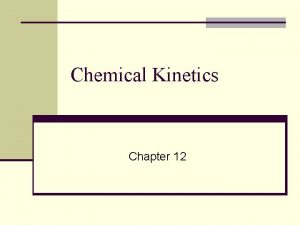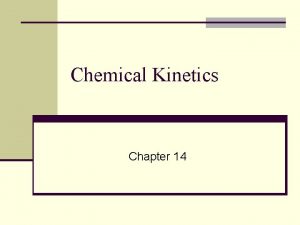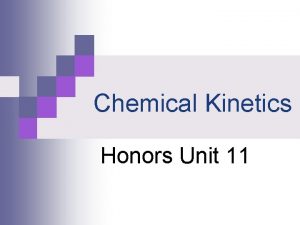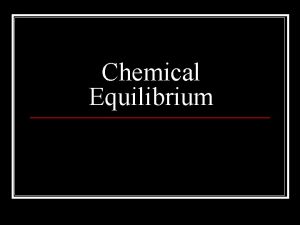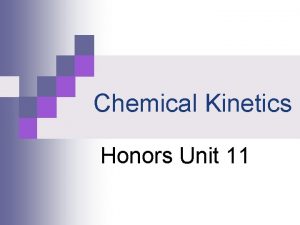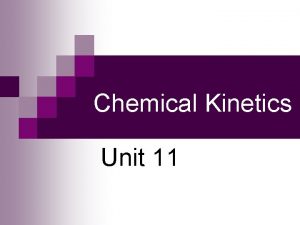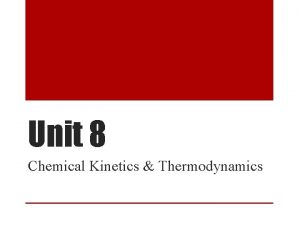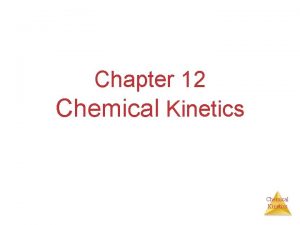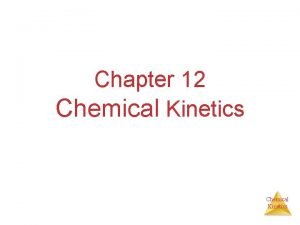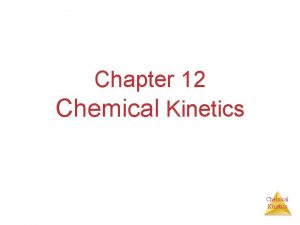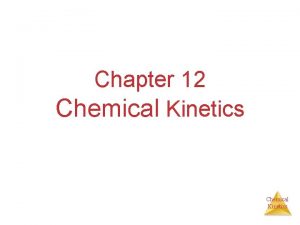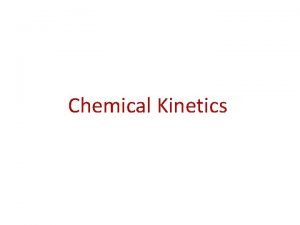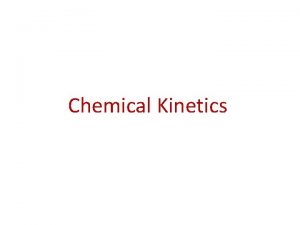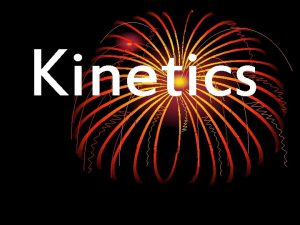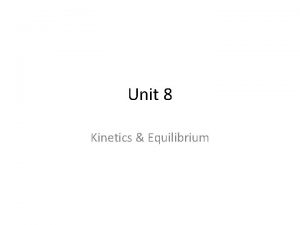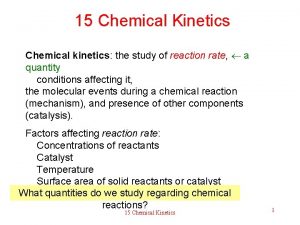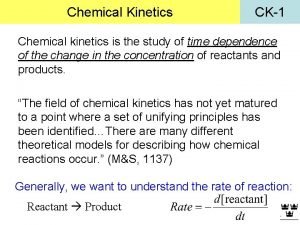Kinetics CHM 116 Chemical Kinetics tells us Studies
















![0. 60000 0. 50000 Concentrations (M) 0. 40000 [I-], M 0. 30000 [SO 42 0. 60000 0. 50000 Concentrations (M) 0. 40000 [I-], M 0. 30000 [SO 42](https://slidetodoc.com/presentation_image/24c5aca2d72eb185449a5797e902cf14/image-17.jpg)

![0. 25000 [I 3 -] 0. 20000 0. 15000 0. 10000 0. 05000 0. 0. 25000 [I 3 -] 0. 20000 0. 15000 0. 10000 0. 05000 0.](https://slidetodoc.com/presentation_image/24c5aca2d72eb185449a5797e902cf14/image-19.jpg)























![Fast Initial Step • Since Rateforward = Raterreverse in step 1 k 1 [NO] Fast Initial Step • Since Rateforward = Raterreverse in step 1 k 1 [NO]](https://slidetodoc.com/presentation_image/24c5aca2d72eb185449a5797e902cf14/image-43.jpg)
![Fast Initial Step Substituting this expression for [NOBr 2] in the rate law for Fast Initial Step Substituting this expression for [NOBr 2] in the rate law for](https://slidetodoc.com/presentation_image/24c5aca2d72eb185449a5797e902cf14/image-44.jpg)













- Slides: 57

Kinetics CHM 116

Chemical Kinetics tells us. . . • Studies the rate at which a chemical process occurs. . . these are expressed in ratios of change in amount of chemical per unit time: – for a reaction A products – Rate of reaction = -D[A]/Dt • Besides information about the speed at which reactions occur, kinetics also sheds light on the reaction mechanism (exactly how the reaction occurs).

Factors That Affect Reaction Rates • Particles must collide in order to react. • The higher the concentration of reactants, the greater the reaction rate. – A higher concentration of reactant particles allows a greater number of collisions. • The physical state of the reactants influences reaction rate. – Substances must mix in order for particles to collide. • The higher the temperature, the greater the reaction rate. – At higher temperatures particles have more energy and therefore collide more often and more effectively. • Catalysts – Speed rxn by changing mechanism.

The simplest reactions are like: A products Zero Order The half-life gets shorter as the reaction proceeds.

A products

A products First Order The half-life is constant – it does not change.

First Order

A products

First-Order example Consider the process in which methyl isonitrile is converted to acetonitrile. CH 3 NC CH 3 CN How do we know this is a first order rxn?

First-Order example CH 3 NC CH 3 CN This data was collected for this reaction at 198. 9°C. Does rate=k[CH 3 NC] for all time intervals? The half-life is constant ~14, 000 sec. . . it does not change.

First-Order Example • ln P is plotted vs. time, a straight line results. – The process is first-order. – k is the negative slope: 5. 1 10 -5 s-1 – Half-life = ln 2/k ≅ ln 2/k = 13, 591 sec (with extra sig figs)

A products Second Order The half-life gets longer as the reaction proceeds.

A products

Another First Order example

Rxns not like A products S 2 O 82 - + 3 I- 2 SO 42 - + I 3 -

S 2 O 82 - + 3 I- 2 SO 42 - + I 3[S 2 O 82 -], M [I-], M [SO 42 -], M [I 3 -], M time, min. 0. 20000 0. 60000 0. 00000 0 0. 10000 0. 30000 0. 20000 0. 10000 1 0. 05000 0. 15000 0. 30000 0. 15000 2 0. 02500 0. 07500 0. 35000 0. 17500 3 0. 01250 0. 03750 0. 37500 0. 18750 4 0. 00625 0. 01875 0. 38750 0. 19375 5 0. 00312 0. 00936 0. 39376 0. 19688 6 0. 00156 0. 00468 0. 39688 0. 19844 7 0. 00078 0. 00234 0. 39844 0. 19922 8
![0 60000 0 50000 Concentrations M 0 40000 I M 0 30000 SO 42 0. 60000 0. 50000 Concentrations (M) 0. 40000 [I-], M 0. 30000 [SO 42](https://slidetodoc.com/presentation_image/24c5aca2d72eb185449a5797e902cf14/image-17.jpg)
0. 60000 0. 50000 Concentrations (M) 0. 40000 [I-], M 0. 30000 [SO 42 -], M [I 3 -], M [S 2 O 82 -], M 0. 20000 0. 10000 0. 00000 0 1 2 3 4 5 time (minutes) 6 7 8

Rxns not like A products S 2 O 82 - + 3 I- 2 SO 42 - + I 3 -
![0 25000 I 3 0 20000 0 15000 0 10000 0 05000 0 0. 25000 [I 3 -] 0. 20000 0. 15000 0. 10000 0. 05000 0.](https://slidetodoc.com/presentation_image/24c5aca2d72eb185449a5797e902cf14/image-19.jpg)
0. 25000 [I 3 -] 0. 20000 0. 15000 0. 10000 0. 05000 0. 00000 0 1 2 3 4 5 6 7 8 time (min) Instantaneous rates can be approximated by finding average rates (or by drawing tangent lines to determine slopes).

Rate laws can be determined from experimental data – vary conc. and determine the impact on the rate of the reaction. Initial Concentrations (M) Initial Rate of Rxn. mole/ Rate Constant Expt. # [S 2 O 82 -] [I-] 1 0. 76 0. 30 1. 40 E-05 6. 14 E-05 2 0. 38 0. 60 1. 40 E-05 6. 14 E-05 3 0. 76 0. 60 2. 80 E-05 6. 14 E-05 Lsec k

Rate Law from Initial rates • Find m and n by examination of rate data – Does doubling a conc. double the rate? – Does a conc. change cause no rate change? • The “order” of the reaction can be determined for each reagent AND the overall order is the sum of those orders. – In this case the overall order is 2 (m = n = 1) • Determine k once we know the order.

Reaction Coordinate Diagrams – visualization of reaction pathways The rearrangement of methyl isonitrile.

Reaction Coordinate Diagrams

The Collision Model • In a chemical reaction, bonds are broken and new bonds are formed. • Molecules can only react if they collide with each other. • The collisional frequency (Z) is proportional to the concentration(s) of the molecule(s) that must collide: Z µ [A][B] • [A] and [B] may be raised to powers ≠ 1

The Collision Model Furthermore, molecules must collide with the correct orientation and with enough energy to cause bond breakage and formation.

Activation Energy Barrier The larger the Activation Energy Barrier (Ea), the harder it is for the reaction to proceed.

Energy relationships DHrxn = Ea(fwd) – Ea(rev) Transition state Ea= 19 k. J transition state DHrxn = -392 k. J Ea(rev)= (392 + 19) k. J = 411 k. J So Ea(rev) = + Ea(fwd) - DHrxn = 19 k. J – (-392 k. J) = 411 k. J

The fraction (f) of molecules with energy sufficient to overcome the barrier height is:

Temperature and Rate • Generally, as temperature increases, so does the reaction rate. • This is because k is temperature dependent. • Rule of thumb. . . A doubling of rate occurs when T increases by 10°C


Steric Factor: depends on nature of the molecularity and type of chemical reaction.

Figure 16. 21 Reaction energy diagrams and possible transition states for two reactions.

Effect of Catalyst In the simplest view, a catalyst only reduces the size of Ea. The reality is that the catalytic pathway also will have different steric factors and altered collision frequency statistics.

Reaction Mechanisms The sequence of events that describes the actual process by which reactants become products is called the reaction mechanism. • Reactions may occur all at once or through several discrete steps. • Each of these processes is known as an elementary reaction or elementary process.

Reaction Mechanisms A valid mechanism must satisfy two (three) criteria: • The elementary steps must add up to the overall balanced equation. • The mechanism must predict the observed rate law. • (The elementary steps must be reasonable. ). . . Stating this is really a bit unnecessary A mechanism that satisfies these criteria is said to consistent with experiment – we cannot prove a mechanism is correct without doing additional experimentation (ex. isolating intermediates, observing fleeting transition states, or using computational methods to validate our model of the reaction.

Multistep Mechanisms • In a multistep process, one of the steps will be slower than all others. • The overall reaction cannot occur faster than this slowest, rate-determining step.

Slow Initial Step NO 2 (g) + CO (g) NO (g) + CO 2 (g) • The experimentally determined rate law is Rate = k [NO 2]2 • CO is necessary for this reaction to occur, but the rate of the reaction does not depend on its concentration. • This suggests the reaction occurs in more than one step.

Slow Initial Step • A proposed mechanism for this reaction is Step 1: NO 2 + NO 2 NO 3 + NO (slow) Step 2: NO 3 + CO NO 2 + CO 2 (fast) • The NO 3 intermediate is consumed in step 2. • As CO is not involved in the slow, rate-determining step, it does not appear in the rate law.

Fast Initial Step • The rate law for this reaction is found (experimentally) to be • This rate law is consistent with a single-step reaction …. BUT …. • Because termolecular (= trimolecular) processes are rare, this rate law suggests a two-step mechanism.

Fast Initial Step • A proposed mechanism is Step 1 is an equilibriumit includes the forward and reverse reactions.

Fast Initial Step • The rate of the overall reaction depends upon the rate of the slow step. • The rate law for that step would be • But NOBr 2 is an intermediate … how can we find [NOBr 2]?

Fast Initial Step • NOBr 2 can react two ways: – With NO to form NOBr (which is slow) – Or decomposition to reform NO and Br 2 (which is fast) • The reactants and products of step 1 are in equilibrium with each other. • Equilibrium occurs when Rateforward = Ratereverse
![Fast Initial Step Since Rateforward Raterreverse in step 1 k 1 NO Fast Initial Step • Since Rateforward = Raterreverse in step 1 k 1 [NO]](https://slidetodoc.com/presentation_image/24c5aca2d72eb185449a5797e902cf14/image-43.jpg)
Fast Initial Step • Since Rateforward = Raterreverse in step 1 k 1 [NO] [Br 2] = k− 1 [NOBr 2] Solving for [NOBr 2] gives us k 1 [NO] [Br ] = [NOBr ] 2 2 k− 1
![Fast Initial Step Substituting this expression for NOBr 2 in the rate law for Fast Initial Step Substituting this expression for [NOBr 2] in the rate law for](https://slidetodoc.com/presentation_image/24c5aca2d72eb185449a5797e902cf14/image-44.jpg)
Fast Initial Step Substituting this expression for [NOBr 2] in the rate law for the rate-determining step gives

H 2(g)+ 2 ICl (g) → I 2 (g)+ 2 HCl (g) Reaction of iodine-monochloride (ICl) and hydrogen (H 2)produces iodine (I 2) and hydrogen chloride (HCl) as products. The experimentally determined rate law is : rate = k [H 2] [ICl] A two step reaction mechanism is proposed – can it be correct? (1) slow reaction: H 2+ ICl → HI + HCl Rate(1): k 1 [H 2] [ICl] (2) fast reaction: HI + ICl → I 2 + HCl Rate(2): k 2 [HI] [ICl] Overall reaction: H 2 + 2 ICl → I 2+ 2 HCl

Visualizing the reaction pathway: a two step mechanism.

Rate limiting elementary processes • The molecularity of a process tells how many molecules are involved in the process. • The rate law for an elementary step is written directly from that step.

Catalysts • Catalysts increase the rate of a reaction by decreasing the activation energy of the reaction. • Catalysts change the mechanism by which the process occurs, which can also change collisional frequencies and the steric factors involved in the rate constant

Homogeneous Catalysts • Catalyst exists in the same physical phase as reactants. SLOW Fast Slow overall

Heterogeneous Catalysts • Catalyst exists in a different physical phase than reactants.

Heterogeneous Catalysts

Diesel emissions

Enzymes • Enzymes are catalysts in biological systems. • The substrate fits into the active site of the enzyme much like a key fits into a lock.


This is a solution to a text problem. The question was “Using the initial rate data, determine the experimental rate law. Predict which step in the proposed mechanism must be rate limiting. ” Identify any error(s) in the answer given below.

Steady state approximation In some Reaction Mechanisms, more than one elementary step may control the rate of the reaction. In such mechanisms, we make no assumptions about the rates of the steps within the mechanism. For example take the reaction of nitric oxide with oxygen: (1) NO+ NO → N 2 O 2 (2) N 2 O 2 +O 2 → 2 NO 2 Overall reaction: 2 NO + O 2 → 2 NO 2 To find the overall reaction rate without knowledge of the ratedetermining step, assume that the reaction rate of each elementary step is equal. Select one of the elementary steps and write the reaction rate: Ex. for step 2 we can write Reaction Rate = k 2 [N 2 O 2][O 2].

To eliminate the reaction intermediate (N 2 O 2) from the rate law, we assume that the [N 2 O 2] reaches a steady-state condition (it is being produced and consumed at equal rates); that is rate of formation of N 2 O 2 = rate of disappearance of N 2 O 2 The rate of formation of N 2 O 2 = k 1[NO]2. . But the N 2 O 2 can “disappear” in both the reverse reaction in step 1 or the forward direction in step 2 which gives us this relationship rate of disappearance of N 2 O 2 = k-1[N 2 O 2] + k 2[N 2 O 2][O 2] k 1[NO]2 = k-1[N 2 O 2] + k 2[N 2 O 2][O 2] Rearranging this equation will give us [N 2 O 2] = k 1[NO]2/(k-1+k 2[O 2]) Plugging in this value of [N 2 O 2] into our beginning rate of reaction of the elementary step will provide us with the overall reaction of the mechanism: rate = (k 1 k 2[O 2][NO]2)/(k-1+k 2[O 2])
 Chemical machining (chm)
Chemical machining (chm) Applications of chemical kinetics
Applications of chemical kinetics Order kinetics
Order kinetics Define steady state approximation
Define steady state approximation Chemical kinetics definition
Chemical kinetics definition Molecularity
Molecularity Chemical kinetics experiment
Chemical kinetics experiment Chemistry grade 11 unit 4
Chemistry grade 11 unit 4 Chm 130 chapter 12 practice problems answer key
Chm 130 chapter 12 practice problems answer key Contoh mesin non konvensional
Contoh mesin non konvensional Chm 111
Chm 111 Chm 241
Chm 241 Chmportal
Chmportal Chemistry 151 final exam
Chemistry 151 final exam Chm 201
Chm 201 Chm logo
Chm logo Chemistry
Chemistry Chm 1045
Chm 1045 A chemical formula tells what
A chemical formula tells what Paradigm shift from women studies to gender studies
Paradigm shift from women studies to gender studies Octet stanza
Octet stanza Sonnet 116 theme
Sonnet 116 theme Theme of sonnet 30 by william shakespeare
Theme of sonnet 30 by william shakespeare What do the hawks symbolize in the alchemist
What do the hawks symbolize in the alchemist Indas116
Indas116 116 sonetas
116 sonetas Quran 5 116
Quran 5 116 Cwe-116
Cwe-116 Sonnet 116 figurative language
Sonnet 116 figurative language Lucasmod
Lucasmod Liz buys packets of coloured buttons
Liz buys packets of coloured buttons Psalm 1-9
Psalm 1-9 Devyniu eiluciu strofa
Devyniu eiluciu strofa Psalms 116 3
Psalms 116 3 Cos 116
Cos 116 Much madness is divinest sense line by line analysis
Much madness is divinest sense line by line analysis Afi 48-116
Afi 48-116 Sonnet 18
Sonnet 18 Pg 116
Pg 116 Salmo 116 1-9
Salmo 116 1-9 William wordsworth sonnet upon westminster bridge
William wordsworth sonnet upon westminster bridge Villa hareskovby
Villa hareskovby 2551m deadline
2551m deadline Salmo 116 15
Salmo 116 15 Systolic mm hg
Systolic mm hg Psalm 19 niv
Psalm 19 niv Nahl 116
Nahl 116 Pomeron
Pomeron 116 qq
116 qq Section 2 classifying chemical reactions
Section 2 classifying chemical reactions Chemical formulas and chemical compounds chapter 7 review
Chemical formulas and chemical compounds chapter 7 review Empirical formula and molecular formula pogil
Empirical formula and molecular formula pogil Chapter 18 chemical reactions balancing chemical equations
Chapter 18 chemical reactions balancing chemical equations Section 2 classifying chemical reactions
Section 2 classifying chemical reactions Chemical reactions section 1 chemical changes
Chemical reactions section 1 chemical changes Kinetics of crystal violet fading
Kinetics of crystal violet fading Rate of elimination of drug
Rate of elimination of drug Growth kinetics
Growth kinetics
